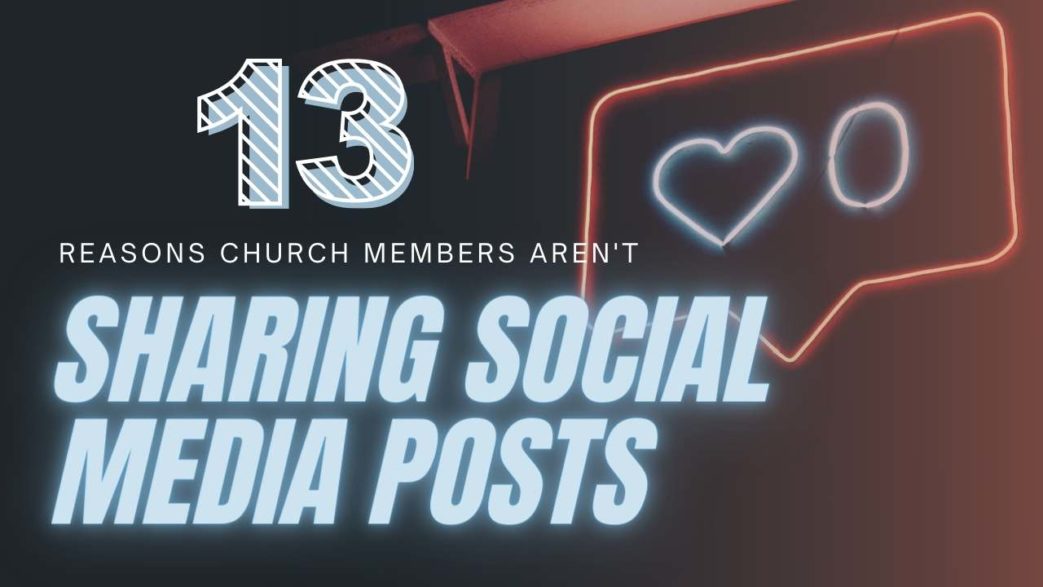Social media should be one of your church’s most useful tools, but it won’t work if members aren’t sharing your social media posts.
It’s an all too common problem. Churches start posting, but nothing happens. There’s no sharing, commenting, liking, or anything else. Just silence.
Before giving up, take a minute to reevaluate your strategy. Simply changing what you’re posting could drastically change how effective social media is for your church.

1. They’re Just Church Announcements
Advertising upcoming events is a great use of social media. However, it shouldn’t be the only thing your church is doing on the platform. Church members aren’t sharing your social media posts because it’s all advertisements.
For some major events, they might share the posts to invite friends and family. Otherwise, they won’t share posts about upcoming meetings or simply reminding people about weekly service times. While they want to invite others, they don’t want to pester their friends and family. They’ll only share the occasional invite to avoid annoying people.
Share church announcements and events, but make sure you’re sharing other content too. Share snippets from the previous week’s sermon. Write an engaging blog post to share. Mix it up and your members are much more likely to share.
2. They’re Too Controversial
Social media has turned into a place where controversy thrives. People want to share their opinions and get worked up easily when others chime in with varying opinions. Usually, it just turns into massive arguments.
When your church starts to post controversial content, your members might not share it. In fact, they may just stop following your church or at the very least, mute you so you’re not appearing on their feeds. All the controversy is draining and it actually takes energy away being able to interact with people offline.
It could be something as simple as your church expressing support for a political candidate or taking a stance on a recent local issue. While your church should be ethical, it’s a good idea to avoid being too opinionated. Provide scripture to help guide without telling people which side of a debate to be on.
Keeping as much controversy off your church’s social media pages as possible provides your members a safer place online. By posting alternative content, you give them something better to share with others that’s not just causing more anger. There are some things that your church shouldn’t share.
3. Everything’s Negative
Why do memes and funny videos take off so quickly? They’re an escape from the constant barrage of negative news people see daily. Your members might not be sharing your social media posts because they’re just more of the same – doom and gloom.
Some churches share news stories to help keep members informed. They might also share blog posts that talk about how bad the world currently is. But, instead of helping, it just hurts your members’ mental health.
With so much negative news and posts on social media, people see things with a negative bias. It makes them harder to see the good in anything. They’ll even blow small negative issues out of proportion and work extra hard to confirm their beliefs.
It’s okay to talk about the current state of affairs. But, provide some hope at the end of the tunnel. Help bring an end to some of the negative thinking.
Whether your members have already fallen prey to the negative psychology from negative social media posts, they might not share your negative posts because the posts don’t match their opinions.
So, avoid the negative and try to put a positive spin on things whenever possible.

4. Only Members Would Understand Them
Every church has their own lingo. You have abbreviations and nicknames for ministry groups. Each volunteer project has their own name. While it’s fine to use those names in church or in a group on Facebook, try to avoid them in your main posts.
It’s hard for non-members to really understand them. This means your members won’t be sharing the posts because they don’t want to have to explain everything to others.
In order to increase sharing, keep member-only types of posts within a group or add “Member Announcement” to the start of your posts so it’s easy to tell the post is meant specifically for active church members.
5. There’s No Image Or Video
Even if you’re posting great content, your members might not be sharing your social media posts. The reason is they just don’t notice it. Remember, you’re trying to grab their attention when their feeds are already filled with the posts of possibly hundreds of friends along with various brands and groups they follow.
But, even the smallest churches can stand out on social media by doing one thing – adding images or videos. Statistics have shown that video content performs much better than text alone. Even just having an image gets your content noticed far more than text.
You need a visual element to get members to notice your church’s posts. It could be something as simple as a background image with scripture on top. Or, create a video montage of your volunteers hard at work to show how you’re helping the community.
You can still have text-only posts. But, make those the minority. If you want your members to share your posts, they first have to notice them. Then, the more they engage with your church’s posts, the more often your posts appear in their feed, increasing the chances of more sharing.
6. It’s Fake News
It’s a sad fact, but social media users are more likely to believe and share fake news. Of course, this doesn’t mean your church should post fake news. In fact, do the opposite.
If your members figure out that your church is sharing fake news, it could cause them to distrust you. Then, they won’t share any of your posts, no matter what they are.
Another consequence is your posts may be deleted. This leaves your members wondering why you deleted the content, forcing you to have to admit you accidentally shared fake news.
You probably aren’t sharing fake news on purpose. You find what seems like a believable story and you want to share it with your members. But, you can’t always trust what you read on social media. Do your research and ensure it’s true before you post it.
ABC News and Forbes offer up tips on how to spot fake news so you don’t share the wrong thing. A good rule of thumb is if you’re not completely certain, just don’t post it.

7. Members Don’t Agree With Your Views
You’ll never please everyone. That’s also why it’s a good idea for churches to avoid posting opinions to social media. The biggest issue is the opinion might not be that of your church, but simply that of a staff member in charge of social media.
However, when members don’t agree with your views, they’re not sharing your social media posts. The wrong view point may even go against your church’s values, causing members to question the church.
Ensure that every post goes through at least two different staff members or volunteers before being posted. This helps reduce opinion posts or knee-jerk reactions to events.
Even if your opinion isn’t necessarily controversial, it’s still just that, an opinion. It’s better to stick with facts or inspiring content instead.
8. They’re Too Preachy
Sometimes, church content can come off as too preachy. The problem is this leaves members feeling bad about themselves. Instead of providing guidance on how to follow God’s word, the posts make members feel like they’ll never be good enough.
This goes back a little to the negative content. Your church needs to inspire people and guide them. You can post about the problems in the world, but post realistic solutions to help people take action.
Post content that makes your members feel hopeful. You can even post something funny that helps brighten their day.
9. It’s Not Useful For Others
One of the first rules of creating social media content people actually want to share is to make it useful and engaging. If members don’t think their friends and family will find the post useful, they won’t share it. Think about the types of content that would be useful to a wide variety of people, outside of just your members.
For example, sharing scripture is great. But, if members share it with people who’ve never been to church, they might not understand what it means. So, share scripture, but offer a great images to go with it or even a quick caption to explain it.
Some examples of useful content for your church to share include:
- Links to useful blog posts
- Share content from other churches and Christian leaders
- Show what your volunteers do
- Promote your groups (both online and offline)
- Share a link to your sermon or livestreaming services
- Guide people on how they can help their communities, even if they’re not members
- Have a weekly prayer request post
- Offer guidance for common issues
- Share a Christian joke
- Create videos of Q&A sessions
The more engaging your content is, the more likely your members are to share it.

10. They’re Not Christian
This one might sound odd, but some churches take a different approach to social media. They want to avoid sounding like a church in order to attract more followers. As a result, they post content that’s not exactly Christian. It could be questionable memes or videos, links to blog posts filled with foul language or showing support for celebrities or politicians with no Christian values.
When the content you’re posting isn’t Christian, your church members won’t share it. Not only does it look bad on your church, but it’ll look bad on your members too.
Everything you share doesn’t have to be specifically Christian. For instance, you might share a fun post about New Year’s resolutions. It’s something useful for your members, but not directly related to your church.
As long as the content is appropriate and doesn’t go against your church’s values, it’s okay. Just make sure to add a mixture of obviously Christian content in too.
11. You’re Always Asking For Something
Everyone’s probably had that one friend at some point in their lives that always seems to need something. They might be short when you go to lunch together or they’re behind on their bills. Maybe they’re always asking you to help them do things around their house. The problem is the friend might not always be there for you.
When your church constantly posts content asking for something, it makes your members feel like you’re that one friend. Social media is a great place to help boost online giving, but don’t make that your main goal.
If all of your content involves asking for donations, your members won’t keep sharing the content. This is because their friends and family are going to start asking questions about how the money’s used.
You can ask for donations, but make sure it’s not all the time. Ask once a week and state what the funds are used for. For instance, one week, promote your youth ministry and have a quick fundraiser for that. The next week ask members to help donate to the local soup kitchen.
Asking less often and making it obvious what the money is for makes it easier for members to understand and makes them want to share the posts. Plus, it makes your church seem less needy.
12. You Only Share Your Own Content
A common complaint with social media is you don’t know what to post. Every brand struggles with this, including churches. The great part is you don’t have to just post your own content.
Sometimes, your members aren’t sharing your social media posts because they’re afraid it’ll seem like they’re just trying to push their friends into attending. To avoid any issues, they just don’t share.
So, offer them up a variety of sources. Not only does this give them more options for sharing, but it allows you to post more often without feeling overwhelmed with creating new content yourself.
13. They’re Not On The Same Network As Your Church
There aren’t just a few social networks out there. For example, just a few years ago, TikTok was just getting started, but now it’s everywhere.
You might be posting the most amazingly useful content, but no one’s seeing it. The problem is your members might not be on the same network as your church.
Take a survey to see where your members are online. If you’re using Twitter, but the majority of your members use Facebook and Instagram, it’s time to move. After all, members can’t share something if they don’t see it.
Give your members plenty of great content to share on social media by creating your own church blog. Contact us today to learn how to set up a church website and blog today.




